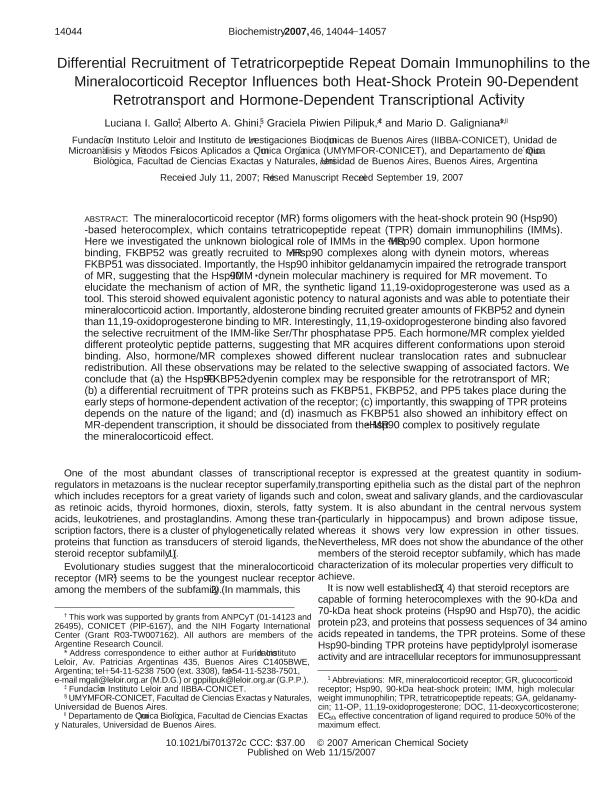Mostrar el registro sencillo del ítem
dc.contributor.author
Gallo, Luciana Ines

dc.contributor.author
Ghini, Alberto Antonio

dc.contributor.author
Piwien Pilipuk, Graciela

dc.contributor.author
Galigniana, Mario Daniel

dc.date.available
2017-12-13T20:29:30Z
dc.date.issued
2007-11
dc.identifier.citation
Gallo, Luciana Ines; Ghini, Alberto Antonio; Piwien Pilipuk, Graciela; Galigniana, Mario Daniel; Differential Recruitment of Tetratricorpeptide Repeat Domain Immunophilins to the Mineralocorticoid Receptor Influences both Heat-Shock Protein 90-Dependent Retrotransport and Hormone-Dependent Transcriptional Activity; American Chemical Society; Biochemistry; 46; 49; 11-2007; 14044-14057
dc.identifier.issn
0006-2960
dc.identifier.uri
http://hdl.handle.net/11336/30527
dc.description.abstract
The mineralocorticoid receptor (MR) forms oligomers with the heat-shock protein 90 (Hsp90) -based heterocomplex, which contains tetratricopeptide repeat (TPR) domain immunophilins (IMMs). Here we investigated the unknown biological role of IMMs in the MR·Hsp90 complex. Upon hormone binding, FKBP52 was greatly recruited to MR·Hsp90 complexes along with dynein motors, whereas FKBP51 was dissociated. Importantly, the Hsp90 inhibitor geldanamycin impaired the retrograde transport of MR, suggesting that the Hsp90·IMM·dynein molecular machinery is required for MR movement. To elucidate the mechanism of action of MR, the synthetic ligand 11,19-oxidoprogesterone was used as a tool. This steroid showed equivalent agonistic potency to natural agonists and was able to potentiate their mineralocorticoid action. Importantly, aldosterone binding recruited greater amounts of FKBP52 and dynein than 11,19-oxidoprogesterone binding to MR. Interestingly, 11,19-oxidoprogesterone binding also favored the selective recruitment of the IMM-like Ser/Thr phosphatase PP5. Each hormone/MR complex yielded different proteolytic peptide patterns, suggesting that MR acquires different conformations upon steroid binding. Also, hormone/MR complexes showed different nuclear translocation rates and subnuclear redistribution. All these observations may be related to the selective swapping of associated factors. We conclude that (a) the Hsp90·FKBP52·dyenin complex may be responsible for the retrotransport of MR; (b) a differential recruitment of TPR proteins such as FKBP51, FKBP52, and PP5 takes place during the early steps of hormone-dependent activation of the receptor; (c) importantly, this swapping of TPR proteins depends on the nature of the ligand; and (d) inasmuch as FKBP51 also showed an inhibitory effect on MR-dependent transcription, it should be dissociated from the MR·Hsp90 complex to positively regulate the mineralocorticoid effect.
dc.format
application/pdf
dc.language.iso
eng
dc.publisher
American Chemical Society

dc.rights
info:eu-repo/semantics/openAccess
dc.rights.uri
https://creativecommons.org/licenses/by-nc-sa/2.5/ar/
dc.subject
Hsp90
dc.subject
Mineralocorticoid Receptor
dc.subject
Immunophilins
dc.subject.classification
Otras Ciencias Biológicas

dc.subject.classification
Ciencias Biológicas

dc.subject.classification
CIENCIAS NATURALES Y EXACTAS

dc.title
Differential Recruitment of Tetratricorpeptide Repeat Domain Immunophilins to the Mineralocorticoid Receptor Influences both Heat-Shock Protein 90-Dependent Retrotransport and Hormone-Dependent Transcriptional Activity
dc.type
info:eu-repo/semantics/article
dc.type
info:ar-repo/semantics/artículo
dc.type
info:eu-repo/semantics/publishedVersion
dc.date.updated
2017-10-12T19:54:58Z
dc.journal.volume
46
dc.journal.number
49
dc.journal.pagination
14044-14057
dc.journal.pais
Estados Unidos

dc.description.fil
Fil: Gallo, Luciana Ines. Consejo Nacional de Investigaciones Científicas y Técnicas. Oficina de Coordinación Administrativa Parque Centenario. Instituto de Investigaciones Bioquímicas de Buenos Aires. Fundación Instituto Leloir. Instituto de Investigaciones Bioquímicas de Buenos Aires; Argentina
dc.description.fil
Fil: Ghini, Alberto Antonio. Consejo Nacional de Investigaciones Científicas y Técnicas. Oficina de Coordinación Administrativa Ciudad Universitaria. Unidad de Microanálisis y Métodos Físicos en Química Orgánica. Universidad de Buenos Aires. Facultad de Ciencias Exactas y Naturales. Unidad de Microanálisis y Métodos Físicos en Química Orgánica; Argentina
dc.description.fil
Fil: Piwien Pilipuk, Graciela. Consejo Nacional de Investigaciones Científicas y Técnicas. Oficina de Coordinación Administrativa Parque Centenario. Instituto de Investigaciones Bioquímicas de Buenos Aires. Fundación Instituto Leloir. Instituto de Investigaciones Bioquímicas de Buenos Aires; Argentina
dc.description.fil
Fil: Galigniana, Mario Daniel. Consejo Nacional de Investigaciones Científicas y Técnicas. Oficina de Coordinación Administrativa Parque Centenario. Instituto de Investigaciones Bioquímicas de Buenos Aires. Fundación Instituto Leloir. Instituto de Investigaciones Bioquímicas de Buenos Aires; Argentina
dc.journal.title
Biochemistry

dc.relation.alternativeid
info:eu-repo/semantics/altIdentifier/doi/http://dx.doi.org/10.1021/bi701372c
dc.relation.alternativeid
info:eu-repo/semantics/altIdentifier/url/http://pubs.acs.org/doi/abs/10.1021/bi701372c
Archivos asociados
